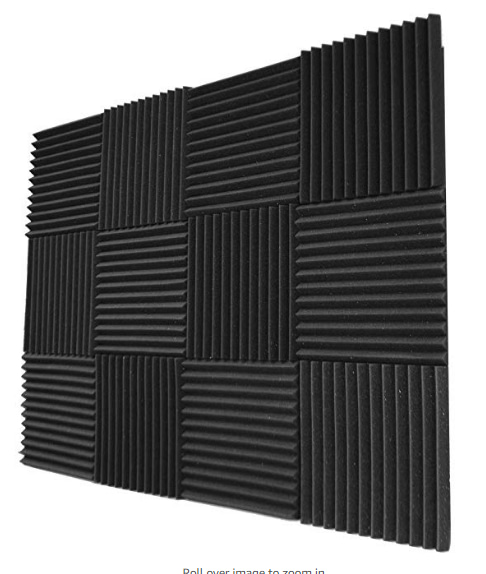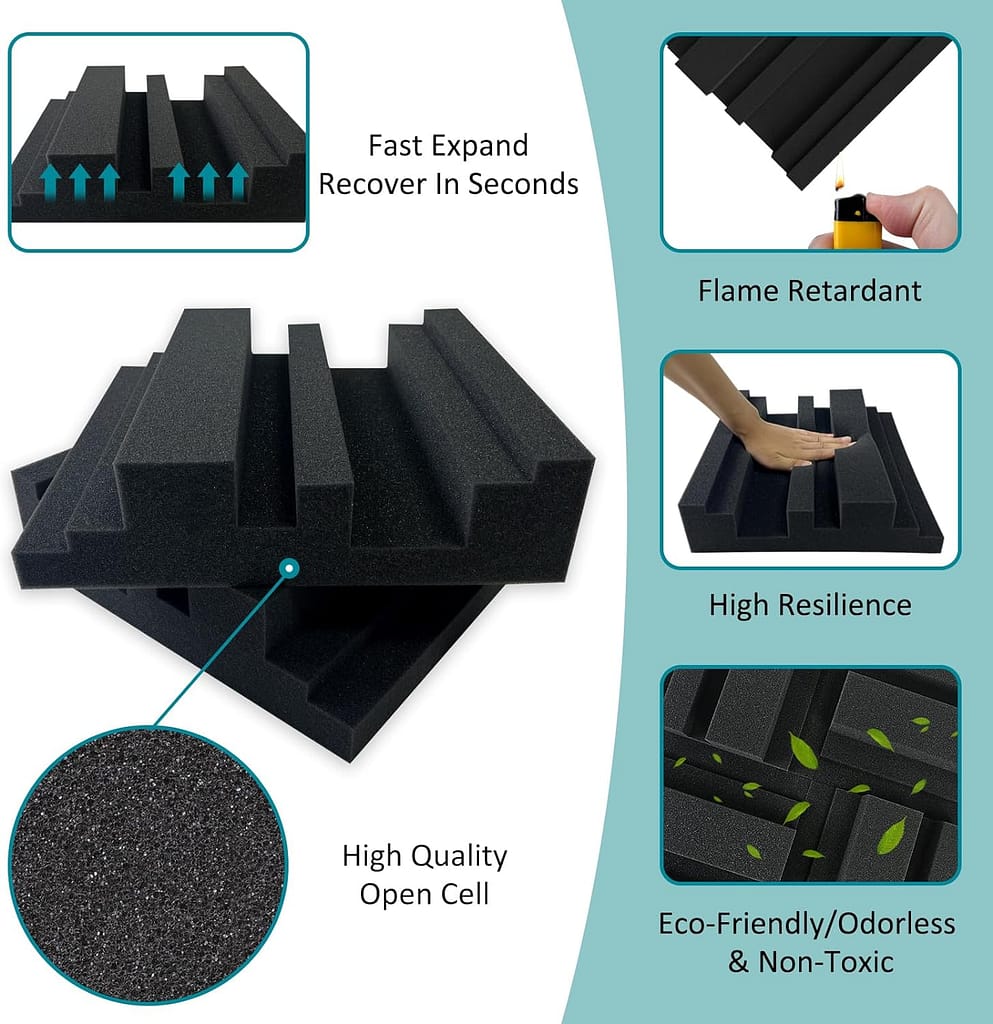Soundproofing vs. Echo Reduction: What’s the Deal?
It’s essential to clarify: soundproof foam panels are more about taming echoes and reverberations than building a fortress of solitude. For those wondering, “Do sound panels keep sound out?” they excel in making interiors sonically pleasant. However, for a space to be completely soundproof, integrating these panels with sound-blocking materials is the way to go.
Do Soundproof Foam Panels Really Work?
Absolutely! Soundproof foam panels are the go-to for diminishing noise within your home. Whether it’s the hustle and bustle of city life or the din from the living room TV, these panels are crafted to absorb sound, effectively reducing echo and enhancing the sound quality of any room. They’re not about blocking noise completely (you’d need heavier artillery like Mass Loaded Vinyl for that) but are more about making your home a sonic sanctuary.

The Magic Behind Soundproof Foam Panels
Crafted with the science of acoustics in mind, soundproof foam panels are your allies in the battle against unwanted noise. Their design targets the reduction of sound transmission, offering a peaceful retreat from external chaos. Available in various sizes, shapes, and even colors, these panels add both function and flair to your space.
When choosing panels, pay attention to their absorption coefficient, sound transmission class (STC), and fire safety ratings to ensure you’re bringing home a product that not only serves its purpose but does so safely. Opting for panels from trusted brands guarantees you get the quality your home deserves.
Creating Your Quiet Corner
Wondering how to 100% soundproof your room? The truth is, achieving total silence is a mix of art and science, involving everything from adding mass to your walls to sealing up the tiniest gaps. It’s about layering defenses—think of soundproof foam as the first, soft layer, perfect for muffling echoes and making your home studio, or any room, sound better.
By integrating soundproof foam panels with other sound-blocking strategies, you can dramatically improve your living environment. It’s a DIY project that delivers peace and tranquility, turning your home into a haven from the noise of the outside world.
| Material | Use Case | Effectiveness | Installation Difficulty | Average Lifespan |
|---|---|---|---|---|
| Soundproof Foam Panels | Home studios, shared walls, apartments | High in echo reduction | Easy | 5-8 years |
| Mass-Loaded Vinyl (MLV) | Walls, ceilings, floors for sound blocking | Very high in sound blocking | Moderate | 10+ years |
| Acoustic Foam | Recording studios, home theaters | Moderate in sound absorption | Easy | 3-5 years |
| Acoustic Panels | Professional studios, commercial spaces | High in sound absorption | Moderate | 5-7 years |
| Sound Insulation Foam | Inside walls, between floors | High in sound insulation | Difficult | 10+ years |
| Door Sealing Strips | Doors and windows to prevent sound leaks | Moderate in sound blocking | Easy | 2-3 years |
| Acoustic Sealants | Gaps and cracks in walls and ceilings | Moderate in sound blocking | Easy | 10+ years |
National Consumer Center offers you a chance to get a $500 gift card to Amazon. The payouts are quick, and you can use the Gift Card to pay for some of your Amazon products.
Table of Contents
Optimal Placement for Soundproof Foam Panels
Where to Install Soundproof Foam Panels?
Soundproof foam panels are a lifesaver in apartments or condos where structural changes are a no-go. They’re also perfect for rooms that echo every sound, offering a simple fix without a big renovation.
Ideal for Music Studios and More
Got a basement music studio? Soundproof foam panels can keep your tunes from becoming everyone’s background track. They’re great for creating a sound barrier that keeps your creativity contained without stifling it.
Noise Reduction Between Rooms
Ever had neighbors mention they can hear your every move? Installing soundproof foam panels on shared walls can drastically reduce the noise leak, making your living space more private and peaceful.
Best Material and Durability
When it comes to blocking sound, mass-loaded vinyl (MLV) is top-notch. But for those on a budget, soundproof foam offers a cost-effective alternative. These panels are durable, lasting several years with proper care, keeping your space quiet and cozy.
Strategic Placement for Maximum Effectiveness
The best spots for your panels? Target high-echo areas and walls adjacent to noisy spaces. Placing panels at ear level can significantly improve room acoustics, but don’t shy away from covering ceilings or door areas for even better sound control. It’s all about finding those spots where sound bounces most and taming the echoes there.
How do you install soundproof foam panels?
It’s straightforward and can be done with a few simple tools. All you need is some glue, scissors, and a pencil. When installing these panels, ensure that they have been correctly installed according to the instructions provided by the manufacturer or supplier. Most of them come with installation kits that allow you to install them quickly without any problems.

There are several ways to apply the glue to the back of the panel. This is a personal preference, but applying it uniformly along the edges is best, leaving about a half-inch from the edge. Use the pencil to make notches in the glue at one-inch intervals.
If you’re using a foam panel cut into individual squares or rectangles, you can use either end of a ruler to make notches in each one. You want to ensure that there are at least two or three notches in each panel to hold them firmly in place when installed.
Once you’ve got your notches cut out, place them on top of each other and put them on your wall in an area where they’ll get plenty of light. The best way to ensure this happens is by placing them against a light source such as a lamp or other lighting fixture. They won’t absorb any of the light coming through and stay cool.
Soundproofing foam panels work by absorbing the sound energy that enters the room. For the best results, use this type of foam in conjunction with other home soundproofing methods:
Soundproofing insulation
Acoustical caulking
Mass-loaded vinyl barriers
Double-paned windows
Soundproofing your home
Ready to transform your living space into a sanctuary of peace and quiet? Dive into our essential guide to soundproofing your home! From selecting the right materials to easy DIY installation tips, we’ve got everything you need to block out unwanted noise and create the tranquil environment you’ve always dreamed of.
Find out more about soundproofing your home’s windows, doors, ceilings, and floors. Don’t let the buzz of the outside world disrupt your peace. Start your soundproofing journey today and enjoy the serene, noise-free home you deserve. Click here to unlock the secrets to a quieter home!
Conclusion
Soundproofing your walls is paramount to any recording or performing musician. If you don’t, you risk being disappointed with the quality of your recordings or performances—and lacking the peace of mind to lay down those takes that are so necessary to the creative process.
Whatever the cause of your unwanted noise, do yourself a favor and address it. The soundproof foam panels we’ve recommended get good reviews and can muffle unwanted sounds just like they’re supposed to.
Good luck and happy soundproofing!
